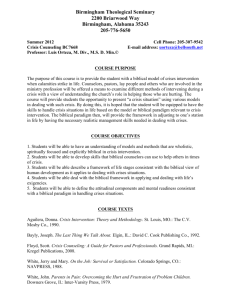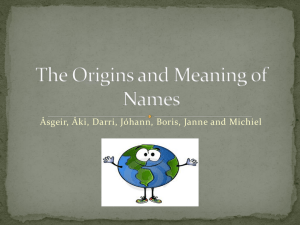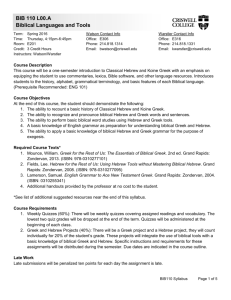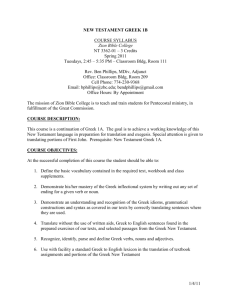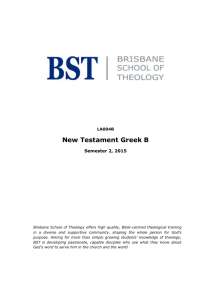A8530
advertisement
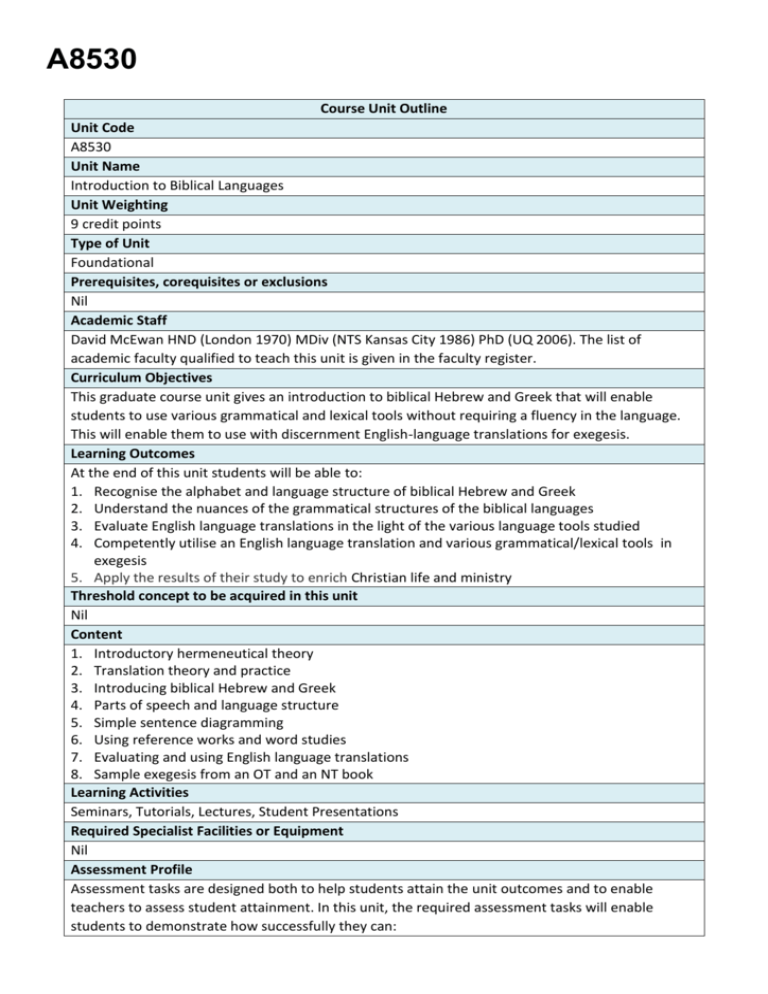
A8530 Course Unit Outline Unit Code A8530 Unit Name Introduction to Biblical Languages Unit Weighting 9 credit points Type of Unit Foundational Prerequisites, corequisites or exclusions Nil Academic Staff David McEwan HND (London 1970) MDiv (NTS Kansas City 1986) PhD (UQ 2006). The list of academic faculty qualified to teach this unit is given in the faculty register. Curriculum Objectives This graduate course unit gives an introduction to biblical Hebrew and Greek that will enable students to use various grammatical and lexical tools without requiring a fluency in the language. This will enable them to use with discernment English-language translations for exegesis. Learning Outcomes At the end of this unit students will be able to: 1. Recognise the alphabet and language structure of biblical Hebrew and Greek 2. Understand the nuances of the grammatical structures of the biblical languages 3. Evaluate English language translations in the light of the various language tools studied 4. Competently utilise an English language translation and various grammatical/lexical tools in exegesis 5. Apply the results of their study to enrich Christian life and ministry Threshold concept to be acquired in this unit Nil Content 1. Introductory hermeneutical theory 2. Translation theory and practice 3. Introducing biblical Hebrew and Greek 4. Parts of speech and language structure 5. Simple sentence diagramming 6. Using reference works and word studies 7. Evaluating and using English language translations 8. Sample exegesis from an OT and an NT book Learning Activities Seminars, Tutorials, Lectures, Student Presentations Required Specialist Facilities or Equipment Nil Assessment Profile Assessment tasks are designed both to help students attain the unit outcomes and to enable teachers to assess student attainment. In this unit, the required assessment tasks will enable students to demonstrate how successfully they can: 1. Demonstrate a basic understanding of the structure and grammar of the biblical languages (e.g. quiz). [Outcomes 1 and 2] 2. Competently utilise the specialist language tools introduced in the unit (e.g. test). [Outcomes 3 and 4] 3. Exegete and present a sample passage from the Old and New Testaments (e.g. seminar, class presentation). [Outcomes 3, 4 and 5] Representative References 1. Colwell, Ernest C. and Ernest W. Tune. A Beginner's Reader-Grammar for New Testament Greek. Peabody: Hendrickson, 2001. 2. Davidson, B. The Analytical Hebrew and Chaldee Lexicon. Peabody: Hendrickson, 1986. 3. Duff, Jeremy and Jonathan T. Pennington. The Elements of New Testament Greek. Cambridge: Cambridge University Press, 2006. 4. Friberg, B. and T. Friberg. The Analytical Greek New Testament. Grand Rapids: Baker, 1981. 5. Kelley, Page H., Terry L. Burden and Timothy G. Crawford. A Handbook to Biblical Hebrew: an Introductory Grammar. Grand Rapids: Eerdmans, 1994. 6. Mounce, W. D. Greek for the Rest of Us: Mastering Bible Study without Mastering Biblical Languages. Grand Rapids: Zondervan, 2003. 7. Mounce, William D. Basics of Biblical Greek: Grammar (3rd ed). Grand Rapids: Zondervan, 2009. 8. Pratico, Gary D. and Miles Van Pelt. Basics of Biblical Hebrew Grammar (2nd ed). Grand Rapids: Zondervan, 2007. 9. Ross, Allen P. Introducing Biblical Hebrew. Grand Rapids: Baker Academic, 2001. 10. Scorgie, Glen G., Mark L. Strauss, and Steven M. Voth. The challenge of Bible translation: communicating God's word to the world. Grand Rapids: Zondervan, 2003. 11. Webb, Joseph M. and Robert Kysar. Greek for Preachers. St. Louis: Chalice Press, 2002. 12. Young, Norman H. and Jonathan T. Pennington. Syntax Lists for Students of New Testament Greek. Cambridge: Cambridge University Press, 2001.

